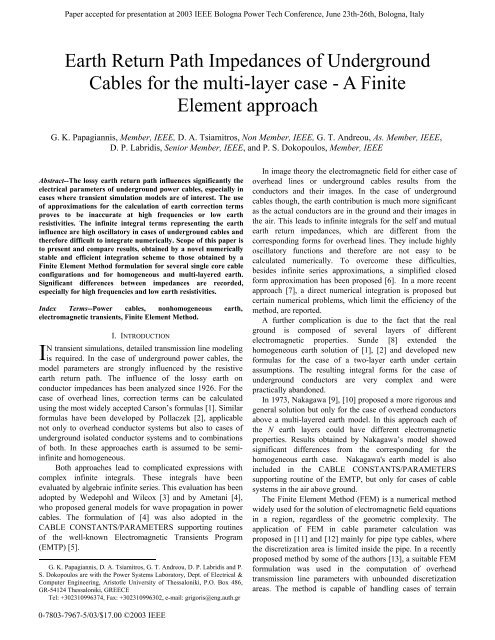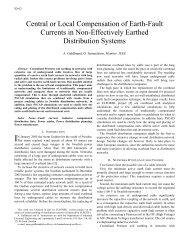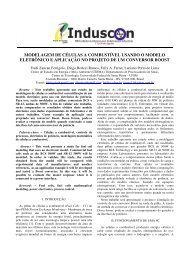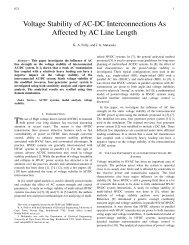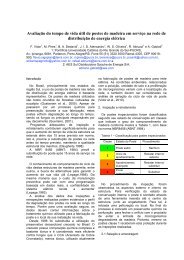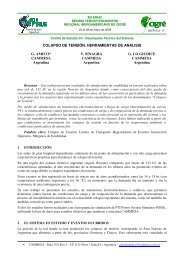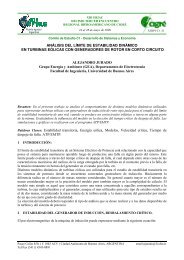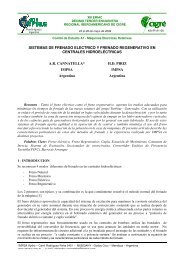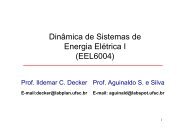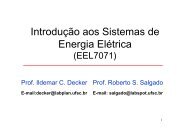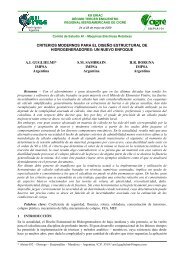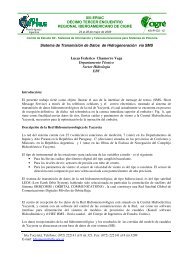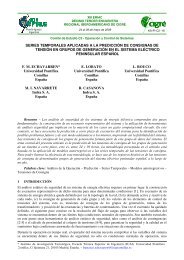Earth Return Path Impedances of Underground Cables for ... - LabPlan
Earth Return Path Impedances of Underground Cables for ... - LabPlan
Earth Return Path Impedances of Underground Cables for ... - LabPlan
You also want an ePaper? Increase the reach of your titles
YUMPU automatically turns print PDFs into web optimized ePapers that Google loves.
<strong>Earth</strong> <strong>Return</strong> <strong>Path</strong> <strong>Impedances</strong> <strong>of</strong> <strong>Underground</strong><br />
<strong>Cables</strong> <strong>for</strong> the multi-layer case - A Finite<br />
Element approach<br />
G. K. Papagiannis, Member, IEEE, D. A. Tsiamitros, Non Member, IEEE, G. T. Andreou, As. Member, IEEE,<br />
D. P. Labridis, Senior Member, IEEE, and P. S. Dokopoulos, Member, IEEE<br />
Abstract--The lossy earth return path influences significantly the<br />
electrical parameters <strong>of</strong> underground power cables, especially in<br />
cases where transient simulation models are <strong>of</strong> interest. The use<br />
<strong>of</strong> approximations <strong>for</strong> the calculation <strong>of</strong> earth correction terms<br />
proves to be inaccurate at high frequencies or low earth<br />
resistivities. The infinite integral terms representing the earth<br />
influence are high oscillatory in cases <strong>of</strong> underground cables and<br />
there<strong>for</strong>e difficult to integrate numerically. Scope <strong>of</strong> this paper is<br />
to present and compare results, obtained by a novel numerically<br />
stable and efficient integration scheme to those obtained by a<br />
Finite Element Method <strong>for</strong>mulation <strong>for</strong> several single core cable<br />
configurations and <strong>for</strong> homogeneous and multi-layered earth.<br />
Significant differences between impedances are recorded,<br />
especially <strong>for</strong> high frequencies and low earth resistivities.<br />
Index Terms--Power cables, nonhomogeneous earth,<br />
electromagnetic transients, Finite Element Method.<br />
I. INTRODUCTION<br />
N transient simulations, detailed transmission line modeling<br />
I is required. In the case <strong>of</strong> underground power cables, the<br />
model parameters are strongly influenced by the resistive<br />
earth return path. The influence <strong>of</strong> the lossy earth on<br />
conductor impedances has been analyzed since 1926. For the<br />
case <strong>of</strong> overhead lines, correction terms can be calculated<br />
using the most widely accepted Carson’s <strong>for</strong>mulas [1]. Similar<br />
<strong>for</strong>mulas have been developed by Pollaczek [2], applicable<br />
not only to overhead conductor systems but also to cases <strong>of</strong><br />
underground isolated conductor systems and to combinations<br />
<strong>of</strong> both. In these approaches earth is assumed to be semiinfinite<br />
and homogeneous.<br />
Both approaches lead to complicated expressions with<br />
complex infinite integrals. These integrals have been<br />
evaluated by algebraic infinite series. This evaluation has been<br />
adopted by Wedepohl and Wilcox [3] and by Ametani [4],<br />
who proposed general models <strong>for</strong> wave propagation in power<br />
cables. The <strong>for</strong>mulation <strong>of</strong> [4] was also adopted in the<br />
CABLE CONSTANTS/PARAMETERS supporting routines<br />
<strong>of</strong> the well-known Electromagnetic Transients Program<br />
(EMTP) [5].<br />
G. K. Papagiannis, D. A. Tsiamitros, G. T. Andreou, D. P. Labridis and P.<br />
S. Dokopoulos are with the Power Systems Laboratory, Dept. <strong>of</strong> Electrical &<br />
Computer Engineering, Aristotle University <strong>of</strong> Thessaloniki, P.O. Box 486,<br />
GR-54124 Thessaloniki, GREECE<br />
Tel: +302310996374, Fax: +302310996302, e-mail: grigoris@eng.auth.gr<br />
In image theory the electromagnetic field <strong>for</strong> either case <strong>of</strong><br />
overhead lines or underground cables results from the<br />
conductors and their images. In the case <strong>of</strong> underground<br />
cables though, the earth contribution is much more significant<br />
as the actual conductors are in the ground and their images in<br />
the air. This leads to infinite integrals <strong>for</strong> the self and mutual<br />
earth return impedances, which are different from the<br />
corresponding <strong>for</strong>ms <strong>for</strong> overhead lines. They include highly<br />
oscillatory functions and there<strong>for</strong>e are not easy to be<br />
calculated numerically. To overcome these difficulties,<br />
besides infinite series approximations, a simplified closed<br />
<strong>for</strong>m approximation has been proposed [6]. In a more recent<br />
approach [7], a direct numerical integration is proposed but<br />
certain numerical problems, which limit the efficiency <strong>of</strong> the<br />
method, are reported.<br />
A further complication is due to the fact that the real<br />
ground is composed <strong>of</strong> several layers <strong>of</strong> different<br />
electromagnetic properties. Sunde [8] extended the<br />
homogeneous earth solution <strong>of</strong> [1], [2] and developed new<br />
<strong>for</strong>mulas <strong>for</strong> the case <strong>of</strong> a two-layer earth under certain<br />
assumptions. The resulting integral <strong>for</strong>ms <strong>for</strong> the case <strong>of</strong><br />
underground conductors are very complex and were<br />
practically abandoned.<br />
In 1973, Nakagawa [9], [10] proposed a more rigorous and<br />
general solution but only <strong>for</strong> the case <strong>of</strong> overhead conductors<br />
above a multi-layered earth model. In this approach each <strong>of</strong><br />
the N earth layers could have different electromagnetic<br />
properties. Results obtained by Nakagawa’s model showed<br />
significant differences from the corresponding <strong>for</strong> the<br />
homogeneous earth case. Nakagawa's earth model is also<br />
included in the CABLE CONSTANTS/PARAMETERS<br />
supporting routine <strong>of</strong> the EMTP, but only <strong>for</strong> cases <strong>of</strong> cable<br />
systems in the air above ground.<br />
The Finite Element Method (FEM) is a numerical method<br />
widely used <strong>for</strong> the solution <strong>of</strong> electromagnetic field equations<br />
in a region, regardless <strong>of</strong> the geometric complexity. The<br />
application <strong>of</strong> FEM in cable parameter calculation was<br />
proposed in [11] and [12] mainly <strong>for</strong> pipe type cables, where<br />
the discretization area is limited inside the pipe. In a recently<br />
proposed method by some <strong>of</strong> the authors [13], a suitable FEM<br />
<strong>for</strong>mulation was used in the computation <strong>of</strong> overhead<br />
transmission line parameters with unbounded discretization<br />
areas. The method is capable <strong>of</strong> handling cases <strong>of</strong> terrain
surface irregularities and non-homogeneous, stratified soil,<br />
where most classical methods usually fail.<br />
Scope <strong>of</strong> this paper is to present a systematic comparison <strong>of</strong><br />
results obtained by different approaches <strong>for</strong> the earth return<br />
impedances <strong>of</strong> underground single core cable arrangements.<br />
First a novel numerical integration technique is proposed and<br />
used <strong>for</strong> the direct calculation <strong>of</strong> the infinite integrals <strong>for</strong> the<br />
case <strong>of</strong> homogeneous earth. This technique is based on a<br />
combination <strong>of</strong> Gauss-Legendre and Gauss-Laguerre methods<br />
with the Lobatto rule [14], in order to overcome efficiently the<br />
problems arising from the oscillative <strong>for</strong>m <strong>of</strong> the infinite<br />
integrals. Results are compared to those obtained by EMTP<br />
<strong>for</strong> several cable arrangements, earth resistivities and<br />
frequencies.<br />
The results by the novel numerical integration technique<br />
are also compared against those obtained by the application <strong>of</strong><br />
the FEM in the case <strong>of</strong> homogeneous earth <strong>for</strong> further<br />
justification.<br />
Finally the FEM <strong>for</strong>mulation is used <strong>for</strong> the analysis <strong>of</strong> two<br />
different cases <strong>of</strong> single core cable arrangements in a twolayered<br />
earth. Six cases <strong>of</strong> two layer earth models, based on<br />
actual electrical ground measurements are investigated.<br />
Results are compared to those <strong>of</strong> the homogeneous earth case.<br />
II. EARTH RETURN IMPEDANCES OF UNDERGROUND CABLE<br />
SYSTEMS<br />
A transmission line is generally described by the two<br />
matrix equations (1) and (2), linking the voltages and currents<br />
<strong>of</strong> the line,<br />
∂<br />
v = −Z′<br />
(ω)<br />
i<br />
(1)<br />
∂z<br />
∂<br />
i = −Y′<br />
(ω)<br />
v<br />
(2)<br />
∂z<br />
where v is the voltage vector with respect to a reference<br />
conductor, i is the current vector and z is the longitudinal<br />
direction along the transmission line. Matrices Ζ΄(ω) and<br />
Υ΄(ω) are the frequency dependent series impedance and<br />
shunt<br />
admittance per unit length matrices, respectively.<br />
For the case <strong>of</strong> an underground cable system Z΄(ω) may be<br />
considered to consist <strong>of</strong> two components [4],<br />
( ω) = Z′<br />
i<br />
( ω) + Z ( ω)<br />
Z ′ ′<br />
(3)<br />
where Z i΄(ω) represents the internal impedances <strong>of</strong> the<br />
conductors in the cable system and Z e΄(ω) accounts <strong>for</strong> the<br />
influence <strong>of</strong> the earth return path. The exact <strong>for</strong>m and the<br />
dimensions <strong>of</strong> the above matrices depend on the number <strong>of</strong><br />
conducting elements <strong>of</strong> each cable, e.g. core, sheath, armor<br />
and on the type and the actual configuration <strong>of</strong> the cable<br />
system. In the case <strong>of</strong> single core (SC) cables, the diagonal<br />
elements <strong>of</strong> Z e΄(ω) represent the impedances <strong>of</strong> the loops<br />
<strong>for</strong>med by the outermost tubular conductor <strong>of</strong> the cables,<br />
either sheath or armor and the earth, while the non-diagonal<br />
elements account <strong>for</strong> the mutual impedances between the<br />
outermost tubular conductors <strong>of</strong> each pair <strong>of</strong> cables and the<br />
e<br />
earth.<br />
Next the cable arrangement <strong>of</strong> Fig. 1 is considered. It<br />
consists <strong>of</strong> two SC cables i and j, buried in the ground, which<br />
is considered to be semi-infinite, homogeneous having an<br />
earth resistivity ρ and relative permeability and permittivity <strong>of</strong><br />
µ r and ε r respectively.<br />
h<br />
Cable i<br />
d<br />
x<br />
D<br />
Image <strong>of</strong> cable j<br />
x<br />
y<br />
y<br />
Cable j<br />
air<br />
earth<br />
ρ, µ r , ε r<br />
Fig. 1: Geometric configuration <strong>of</strong> two SC underground cables.<br />
According to [2], [3], the mutual earth return impedance<br />
between the two underground cables i and j is<br />
where<br />
{ K ( mD) − K ( md ) }<br />
ρm<br />
Z +<br />
2π<br />
2<br />
′<br />
mutual<br />
=<br />
0<br />
0<br />
J m<br />
J<br />
m<br />
∞<br />
2 2<br />
−( h+<br />
y)<br />
a + m<br />
e<br />
jax<br />
= ∫<br />
e da<br />
2 2<br />
−∞ a + a + m<br />
2<br />
= + ( + ) 2<br />
, d x<br />
2 + ( h − y) 2<br />
D x h y<br />
and<br />
K 0<br />
(4)<br />
(5)<br />
= , m=<br />
jωµ<br />
rµ 0<br />
ρ<br />
is the modified complex Bessel function <strong>of</strong> the second<br />
kind with zero order. The self-impedance <strong>for</strong>mula is derived<br />
from (4) and (5) by replacing x = r and y = h , where r is the<br />
radius <strong>of</strong> the outermost surface <strong>of</strong> the cable. By applying some<br />
simple trans<strong>for</strong>mations in (5) the following relation results [8]:<br />
2 2<br />
∞ −( h+<br />
y)<br />
a + m<br />
e<br />
J<br />
m<br />
= 2∫<br />
cos( xa)<br />
da (6)<br />
2 2<br />
0 a + a + m<br />
III. NUMERICAL EVALUATION OF THE INFINITE INTEGRAL<br />
The corresponding expression <strong>for</strong> the mutual earth return<br />
impedances <strong>of</strong> conductors above ground is [1]:<br />
2 ∞ − ( h+<br />
y)<br />
a<br />
ρm<br />
e<br />
Zm′ =<br />
cos( xa)<br />
da<br />
π<br />
∫ (7)<br />
2 2<br />
a+ a + m<br />
0
Equations (4) and (7) differ in two points. First (4) includes<br />
the Bessel functions, which seem to be no serious problem as<br />
they can be evaluated easily using standard library functions.<br />
The key difference though is the fact that the exponential<br />
function in the infinite integral in (6) is complex, while in (7),<br />
it is real. As a result the real and imaginary parts <strong>of</strong> the infinite<br />
integral <strong>of</strong> (7) are monotonic and non-oscillatory functions [1]<br />
and can be calculated by infinite series, which converge<br />
rapidly [5].<br />
In the approach <strong>of</strong> Wedepohl [3] the infinite integral <strong>of</strong> (5)<br />
is divided in parts, each <strong>of</strong> which is approximated using<br />
infinite series. Simplified expressions <strong>of</strong> the general <strong>for</strong>mulas<br />
are also proposed <strong>for</strong> low frequencies and usual cable<br />
configurations.<br />
In the supporting routines CABLE<br />
CONSTANTS/PARAMETERS <strong>of</strong> EMTP, the earth return<br />
impedances <strong>of</strong> cables are calculated using Carson’s <strong>for</strong>mula<br />
(7) <strong>for</strong> overhead conductors, which is evaluated by infinite<br />
series. This approximation is based on the assumption that<br />
a >> m . This is a highly uncertain approximation, which is<br />
obviously false <strong>for</strong> high frequencies and low earth<br />
resistivities. This approximation is used in [5] together with<br />
the approach <strong>of</strong> Wedepohl [3] <strong>for</strong> a single case <strong>of</strong> two<br />
underground conductors. The results are compared with those<br />
obtained by the numerical integration <strong>of</strong> (5), using Romberg<br />
extrapolation [14]. The approximation <strong>of</strong> EMTP shows<br />
significant differences <strong>for</strong> frequencies greater than 10 kHz,<br />
while Wedepohl’s approach is accurate enough at least up to<br />
100 kHz. In the same reference, numerical efficiency<br />
problems concerning the application <strong>of</strong> the integration method<br />
are reported.<br />
Finally direct numerical integration is also used in [7].<br />
Several integration methods, such as Simpson rule and<br />
Romberg rule [14] are tried. Problems concerning the<br />
numerical efficiency <strong>of</strong> all methods are reported, leading to<br />
the adaptation <strong>of</strong> artificial intelligence techniques <strong>for</strong> the<br />
evaluation <strong>of</strong> the infinite integrals.<br />
All above approaches either use approximations, which are<br />
valid only within certain limits, or suffer from numerical<br />
efficiency, which prohibits their generalized application.<br />
There<strong>for</strong>e the problem <strong>of</strong> finding an efficient and accurate<br />
method <strong>for</strong> the numerical evaluation <strong>of</strong> the infinite integral in<br />
(6) is still <strong>of</strong> research interest.<br />
Direct numerical integration <strong>of</strong> the infinite integral is the<br />
method used in this contribution <strong>for</strong> the evaluation <strong>of</strong> (6).<br />
Instead <strong>of</strong> using the previously mentioned integration<br />
methods,<br />
a novel integration technique is used, based on combinations<br />
<strong>of</strong> integration methods. More specifically, the Gauss-<br />
Legendre method, a highly accurate numerical integration<br />
method applicable in finite intervals <strong>of</strong> functions is combined<br />
with two other methods: the Gauss-Laguerre method, which is<br />
best suited <strong>for</strong> infinite integrals and the Lobatto rule, a very<br />
efficient method <strong>for</strong> oscillative functions [14]. The selective<br />
implementation <strong>of</strong> the different integration methods in the<br />
intervals between the roots <strong>of</strong><br />
cos( ax)<br />
, <strong>for</strong> both the real and<br />
the imaginary part <strong>of</strong> J , leads to a quick and very efficient<br />
integration scheme <strong>for</strong> the evaluation <strong>of</strong> (6).<br />
m<br />
IV. THE FINITE ELEMENT APPROACH<br />
The problem <strong>of</strong> the calculation <strong>of</strong> the cable series<br />
impedance matrix in (1) could be greatly simplified, assuming<br />
that the per unit length voltage drop V<br />
i<br />
on every conductor is<br />
known <strong>for</strong> a specific current excitation. The mutual complex<br />
series impedance per unit length Z ′ between conductor i and<br />
another conductor j carrying current I<br />
j<br />
, where all other<br />
conductors are <strong>for</strong>ced to carry zero currents, is then given by:<br />
ij<br />
Vi<br />
Zij<br />
′ = ( i, j = 1, 2, …, n)<br />
(8)<br />
I<br />
j<br />
The self impedance <strong>of</strong> a conductor may also be calculated<br />
from (8), by setting i = j. In such a case, the following<br />
procedure may be used <strong>for</strong> the calculation <strong>of</strong> the cable series<br />
impedance matrix [13]:<br />
• A sinusoidal current excitation <strong>of</strong> arbitrary magnitude is<br />
applied sequentially to each cable conductor, while the<br />
remaining conductors are <strong>for</strong>ced to carry zero currents.<br />
The corresponding voltages are recorded.<br />
• Using (8), the self and mutual impedances <strong>of</strong> the j cable<br />
conductor may be calculated. This procedure is repeated n<br />
times, in order to calculate the impedances <strong>of</strong> n<br />
conductors.<br />
There<strong>for</strong>e, the problem is reduced to that <strong>of</strong> calculating the<br />
actual per unit length voltage drops, when a current excitation<br />
is applied to the conductors. This may be achieved by a<br />
suitable Finite Element Method (FEM) <strong>for</strong>mulation <strong>of</strong> the<br />
electromagnetic diffusion equation.<br />
An underground power cable arrangement, consisting <strong>of</strong><br />
n parallel conductors, is assumed to be long enough to ignore<br />
end effects. Furthermore, if the current density vector is<br />
supposed to be in the z direction, the problem becomes twodimensional<br />
and it is confined in the x-y plane, in which the<br />
conductors’ cross sections lie. The above two-dimensional<br />
diffusion problem is described by the system <strong>of</strong> equations<br />
[15],<br />
where<br />
2 2<br />
1 ⎡∂<br />
Az<br />
∂ A ⎤<br />
z<br />
⎢ + j A<br />
2 2 ⎥− ωσ<br />
z<br />
+ J<br />
µµ<br />
0 r ⎣∂x<br />
∂y<br />
⎦<br />
z sz z<br />
sz<br />
= 0 (9)<br />
− jωσ<br />
A + J = J<br />
(10)<br />
∫∫ JdS<br />
z<br />
= Ii<br />
, i=1, 2, ... , n (11)<br />
Si<br />
A<br />
z<br />
is the z direction component <strong>of</strong> the magnetic vector<br />
potential (MVP).<br />
In (10) the total current density<br />
two components,<br />
J z<br />
is decomposed in
J<br />
z<br />
= Jez + Jsz<br />
(12)<br />
where J<br />
ez<br />
is the eddy current density and J sz<br />
the source<br />
current density, given by (13) and (14) respectively.<br />
J =− jωσ<br />
A<br />
(13)<br />
ez<br />
J<br />
sz<br />
z<br />
=−σ∇Φ (14)<br />
FEM is applied <strong>for</strong> the solution <strong>of</strong> (9) and (10) with the<br />
boundary conditions <strong>of</strong> (11). Values <strong>for</strong> J on each<br />
conductor i <strong>of</strong> conductivity σ<br />
i<br />
are then obtained and equation<br />
(8) takes the <strong>for</strong>m<br />
V J<br />
sz<br />
σ<br />
i<br />
i i<br />
Zij<br />
= = ( i, j = 1, 2, …, n)<br />
(15)<br />
I I<br />
j<br />
j<br />
linking properly electromagnetic field variables and<br />
equivalent circuit parameters.<br />
A distinct advantage <strong>of</strong> the FEM is its capability <strong>of</strong><br />
handling cases <strong>of</strong> geometrical or electromagnetic ground<br />
irregularities <strong>of</strong> almost any kind, where conventional methods<br />
fail.<br />
V. NUMERICAL RESULTS<br />
The proposed numerical integration scheme was applied in<br />
the following cases <strong>of</strong> SC cable arrangements in homogeneous<br />
ground.<br />
First the case <strong>of</strong> a shallowly located SC cable system <strong>of</strong><br />
Fig. 2 was examined [12] in a horizontal (a) and a vertical (b)<br />
cable arrangement. Cable is in a depth h=1,2 m with a spacing<br />
−3<br />
s=0,25m. The core radius is = 23,4 ∗10<br />
m, while the outer<br />
radius is<br />
r S<br />
= 48,4 ∗10<br />
−3<br />
sz i<br />
m. The conductance <strong>of</strong> the cable core<br />
is σ = 5, 88235∗10 7 S/m and µ = 1 <strong>for</strong> the ground.<br />
r C<br />
r<br />
air<br />
earth<br />
h r c<br />
r c r c<br />
h<br />
r c<br />
air<br />
earth<br />
compared to the corresponding obtained by EMTP and FEM<br />
<strong>for</strong> earth resistivities from 2 Ωm up to 1000 Ωm and <strong>for</strong> a<br />
frequency range <strong>of</strong> 1 Hz to 10 MHz. For each case the relative<br />
differences <strong>of</strong> the <strong>for</strong>m <strong>of</strong> (16) were calculated<br />
ZNum<br />
− ZEMTP<br />
Relative difference (%) = ∗ 100 (16)<br />
Z<br />
EMTP<br />
In Fig. 3 the relative differences <strong>for</strong> the magnitude <strong>of</strong> the<br />
self impedance <strong>of</strong> the horizontal cable arrangement <strong>of</strong> Fig. 2<br />
are shown. Differences up to 12% occur, especially <strong>for</strong> low<br />
earth resistivities and high frequencies.<br />
difference(%)<br />
40%<br />
30%<br />
20%<br />
10%<br />
ρ=2 Ωm ρ=10 Ωm<br />
ρ=50 Ωm ρ=100 Ωm<br />
ρ=200 Ωm ρ=300 Ωm<br />
ρ=500 Ωm ρ=1000 Ωm<br />
0%<br />
1,E+00 1,E+01 1,E+02 1,E+03 1,E+04 1,E+05 1,E+06 1,E+07<br />
frequency(Hz)<br />
Fig. 3: Differences in Z 11 between numerical integration and EMTP.<br />
In Fig. 4 the corresponding differences <strong>for</strong> the magnitude<br />
<strong>of</strong> the mutual impedance <strong>of</strong> the cable arrangement are shown.<br />
The differences in this case are due only to the different<br />
approaches in earth return impedance calculation and are<br />
higher reaching up to 25%.<br />
difference(%)<br />
40%<br />
30%<br />
20%<br />
10%<br />
ρ=2 Ωm ρ=10 Ωm<br />
ρ=50 Ωm ρ=100 Ωm<br />
ρ=200 Ωm ρ=300 Ωm<br />
ρ=500 Ωm ρ=1000 Ωm<br />
r s<br />
r s<br />
r s<br />
s<br />
a<br />
s<br />
Fig. 2: Horizontal (a) and vertical (b) SC cable arrangements in homogeneous<br />
ground.<br />
Series impedances were calculated <strong>for</strong> this configuration<br />
using the proposed integration scheme and they were<br />
s<br />
s<br />
b<br />
r s<br />
r c<br />
r c<br />
r s<br />
r s<br />
0%<br />
1,E+00 1,E+01 1,E+02 1,E+03 1,E+04 1,E+05 1,E+06 1,E+07<br />
frequency(Hz)<br />
Fig. 4: Differences in Z 12 between numerical integration and EMTP.<br />
Next the case <strong>of</strong> a SC core cable with core and sheath, as in<br />
Fig. 5 is considered. Original cable data from [3] are<br />
reproduced in Table I. The cable arrangements are similar to<br />
those in Fig. 1 with h=0,75m, s=0,15m and µ<br />
r<br />
= 1 <strong>for</strong> both<br />
media.<br />
The differences <strong>of</strong> (16) were calculated <strong>for</strong> the above cable<br />
arrangement using the previous earth resistivities and<br />
frequencies. In Fig. 6 and Fig. 7 these differences are shown<br />
<strong>for</strong> the case <strong>of</strong> vertical configuration, <strong>for</strong> the real and the<br />
imaginary parts <strong>of</strong> the mutual impedance between the cable
sheaths respectively. Differences <strong>of</strong> almost 25% are recorded<br />
The results <strong>of</strong> the numerical integration were also checked<br />
against the corresponding by FEM <strong>for</strong> all above cases.<br />
Differences calculated by a <strong>for</strong>mula similar to (16) were less<br />
than 1,5% in all cases over the whole range <strong>of</strong> frequencies<br />
sheath<br />
conductor<br />
r 1<br />
r 2<br />
r 3<br />
r 4<br />
impedance matrices <strong>of</strong> cables buried in a two-layered earth.<br />
The two horizontal arrangements, discussed previously, were<br />
considered.<br />
difference (%)<br />
40%<br />
30%<br />
20%<br />
10%<br />
ρ=2 Ωm ρ=10 Ωm<br />
ρ=50 Ωm ρ=100 Ωm<br />
ρ=200 Ωm ρ=300 Ωm<br />
ρ=500 Ωm ρ=1000 Ωm<br />
.<br />
difference (%)<br />
insulation<br />
Fig. 5: Single Core cable with core and sheath.<br />
Core radius<br />
1<br />
TABLE I.<br />
DATA OF THE SC CABLE OF FIG. 5<br />
Main insulation radius r<br />
2<br />
Sheath radius r<br />
3<br />
Outer insulation radius 4<br />
r 2<br />
Dc resistance <strong>of</strong> copper core<br />
Dc resistance <strong>of</strong> lead sheath<br />
40%<br />
30%<br />
20%<br />
10%<br />
ρ=2 Ωm ρ=10 Ωm<br />
ρ=50 Ωm ρ=100 Ωm<br />
ρ=200 Ωm ρ=300 Ωm<br />
ρ=500 Ωm ρ=1000 Ωm<br />
1, 27 ∗10 − m<br />
2, 28∗10 −2 m<br />
2,54∗10 −2 m<br />
r<br />
2<br />
2,79∗10 − m<br />
0,034 Ω/km<br />
0,436 Ω/km<br />
0%<br />
1,E+00 1,E+01 1,E+02 1,E+03 1,E+04 1,E+05 1,E+06 1,E+07<br />
frequency (Hz)<br />
Fig. 6: Real part <strong>of</strong> the mutual impedance <strong>of</strong> cable sheaths. Differences<br />
between numerical integration and EMTP.<br />
. The numerical integration scheme proved to be absolutely<br />
numerically stable. The computation time <strong>for</strong> the numerical<br />
integration was less than 5s <strong>for</strong> a set <strong>of</strong> 280 resistivity and<br />
frequency combinations using an Intel Pentium IV PC at<br />
1,7 GHz.<br />
The case <strong>of</strong> a multi-layered earth was considered next.<br />
Sunde’s extension [8] refers only to conductors over, or on the<br />
surface <strong>of</strong> a multi-layered earth. For the case <strong>of</strong> underground<br />
conductors no solution <strong>for</strong> the electromagnetic field exists.<br />
There<strong>for</strong>e the FEM was used <strong>for</strong> the calculation <strong>of</strong> the<br />
0%<br />
1,E+00 1,E+01 1,E+02 1,E+03 1,E+04 1,E+05 1,E+06 1,E+07<br />
frequency(Hz)<br />
Fig. 7: Imaginary part <strong>of</strong> the mutual impedance <strong>of</strong> cable sheaths. Differences<br />
between numerical integration and EMTP.<br />
Six different two-layered earth models were investigated,<br />
based on actual grounding parameter measurements [16]. The<br />
corresponding data <strong>for</strong> the resistivities <strong>of</strong> the first ρ 1<br />
and<br />
second ρ<br />
2<br />
layer and <strong>for</strong> the depth d <strong>of</strong> the first layer are<br />
shown in Table II. The second layer is <strong>of</strong> infinite extend.<br />
TABLE II.<br />
TWO-LAYERED EARTH MODELS<br />
ρ 1 (Ωm) ρ 2 (Ωm) d(m)<br />
CASE I 372,729 145,259 2,690<br />
CASE II 246,841 1058,79 2,139<br />
CASE III 57,344 96,714 1,651<br />
CASE IV 494,883 93,663 4,370<br />
CASE V 160,776 34,074 1,848<br />
CASE VI 125,526 1093,08 2,713<br />
Cable impedances obtained from FEM <strong>for</strong> the frequency<br />
range <strong>of</strong> 50 Hz to 1 MHz were compared to the corresponding<br />
from the proposed numerical integration scheme, under the<br />
assumption <strong>of</strong> homogeneous earth. The differences calculated<br />
by a <strong>for</strong>mula similar to (16) are shown in Fig. 8 concerning<br />
the magnitude <strong>of</strong> the mutual impedance between the cable<br />
sheaths <strong>of</strong> the SC cable in Fig. 5. The homogeneous earth<br />
model was assumed to have the resistivity ρ<br />
1<br />
<strong>of</strong> the first earth<br />
layer. Differences <strong>of</strong> up to 40% are encountered, even at<br />
power frequency, especially in cases <strong>of</strong> great divergence<br />
between the resistivities <strong>of</strong> the two layers. The differences<br />
seem to be<br />
minimized near the frequencies, <strong>for</strong> which the penetration<br />
depth p given from (17) approaches the depth <strong>of</strong> the first<br />
layer.<br />
1<br />
p = (17)<br />
π f µσ<br />
0
Finally, in Fig. 9 the differences between FEM and<br />
numerical integration in the results <strong>for</strong> the magnitude <strong>of</strong> the<br />
self impedance are shown. The horizontal SC cable<br />
arrangement in Fig. 2 was examined <strong>for</strong> the earth models IV<br />
50%<br />
40%<br />
case Ι<br />
case ΙΙΙ<br />
case ΙΙ<br />
case ΙV<br />
CONSTANTS/PARAMETERS support routine, due to the<br />
assumptions implemented in the latter calculation procedure.<br />
Application <strong>of</strong> FEM in cases <strong>of</strong> underground cables in a<br />
two-layered earth showed differences 15% - 40% from those<br />
obtained with the assumption <strong>of</strong> homogeneous earth. These<br />
differences cannot be disregarded. They justify the need <strong>for</strong><br />
the development <strong>of</strong> a mathematical model <strong>for</strong> multi-layered<br />
earth in the case <strong>of</strong> underground conductors as well as<br />
methods <strong>for</strong> its numerical evaluation.<br />
case V<br />
case VI<br />
difference(%)<br />
30%<br />
20%<br />
10%<br />
0%<br />
1,E+00 1,E+01 1,E+02 1,E+03 1,E+04 1,E+05 1,E+06<br />
frequency(Hz)<br />
Fig. 8: Two-layered earth case. Differences in the magnitude <strong>of</strong> the mutual<br />
impedance.<br />
and VI. In these models the earth resistivities <strong>of</strong> the first and<br />
second layer have their maximum values. FEM results are<br />
compared to those corresponding <strong>for</strong> homogeneous earth<br />
having the resistivity <strong>of</strong> either the first or the second layer.<br />
difference (%)<br />
50%<br />
40%<br />
30%<br />
20%<br />
10%<br />
caseIV, ρ=ρ1<br />
case VI,ρ=ρ1<br />
case IV, ρ=ρ2<br />
case VI,ρ=ρ2<br />
0%<br />
1,E+00 1,E+01 1,E+02 1,E+03 1,E+04 1,E+05 1,E+06<br />
frequency (Hz)<br />
Fig. 9: Two-layered earth case. Differences in the magnitude <strong>of</strong> the self<br />
impedances.<br />
VI. CONCLUSIONS<br />
The problem <strong>of</strong> the calculation <strong>of</strong> the earth return<br />
impedances <strong>of</strong> underground SC power cables was addressed<br />
in this contribution. The available approaches <strong>for</strong> the<br />
numerical evaluation <strong>of</strong> the infinite integrals and the<br />
corresponding assumptions and limitations are reported.<br />
A novel numerical integration scheme, based on proper<br />
combinations <strong>of</strong> integration methods, is proposed. The scheme<br />
proved to be numerically stable and efficient in all examined<br />
cases and lead to results whose validity was justified using a<br />
proper FEM <strong>for</strong>mulation. These results showed differences<br />
10%-25% against those computed from EMTP CABLE<br />
VII. REFERENCES<br />
[1] J. R. Carson, ‘Wave propagation in overhead wires with ground return’,<br />
Bell Syst. Tech. J., Nr. 5, pp.539-554, 1926.<br />
[2] F. Pollaczek, ‘Ueber das Feld einer unendlich langen<br />
wechselstromflossenen Einfachleitung’, Elektrische Nachrichtentechnik<br />
vol.3, pp. 339-359, 1926.<br />
[3] L. M. Wedepohl, D. J. Wilcox, ‘ Transient analysis <strong>of</strong> underground<br />
power-transmission systems. System model and wave propagation<br />
characteristics’, Proc. IEE, vol. 120, No. 2, pp. 253-260, 1973.<br />
[4] A. Ametani, ‘ A general <strong>for</strong>mulation <strong>of</strong> impedance and admittance <strong>of</strong><br />
cables’, IEEE Trans. on P.A.S , vol. PAS-99, No 3, pp. 902-910, 1980.<br />
[5] H. W. Dommel, ‘Electromagnetic Transients Program Reference<br />
Manual’, Boneville Power Administration, Portlant OR, 1986.<br />
[6] O. Saad, G. Gaba, M. Giroux, ‘ A closed-<strong>for</strong>m approximation <strong>for</strong> ground<br />
return impedance <strong>of</strong> underground cables’, IEEE Trans. on Power<br />
Delivery, vol. PWRD-11, No 3, pp. 1536-1545, 1996.<br />
[7] T. T. Nguen, ‘ <strong>Earth</strong> return path impedances <strong>of</strong> underground cables –<br />
Pt.1 Numerical integration <strong>of</strong> infinite integrals, Pt. 2 Evaluations using<br />
neural networks’, Proc. IEE – Generation, Transm., Distr., vol. 145, No<br />
6, pp. 621-633, 1998.<br />
[8] E. D. Sunde, ‘ <strong>Earth</strong> Conduction effects in transmission systems 2nd<br />
Edition’, Dover Publications, 1968, p. 113.<br />
[9] M. Nakagawa, A. Ametani, K. Iwamoto, ‘Further studies on wave<br />
propagation in overhead transmission lines with earth return: Impedance<br />
<strong>of</strong> stratified earth’, Proc. IEE, vol. 120, No 12, pp.1521-1528, 1973<br />
[10] M. Nakagawa, K. Iwamoto, ‘ <strong>Earth</strong> return impedance <strong>for</strong> the multi-layer<br />
case’, IEEE Trans. on P.A.S , vol. PAS-95, No 2, pp. 671 - 676, 1976<br />
[11] S. Cristina, M. Feliziani, ‘ A finite element technique <strong>for</strong> multiconductor<br />
cable parameters calculation’, IEEE Trans. on Magnetics, vol. 25, No. 4,<br />
pp. 2986-2988, 1989.<br />
[12] Y. Yin, H. W. Dommel, ‘ Calculation <strong>of</strong> frequency dependent<br />
impedances <strong>of</strong> underground power cables with finite element method’,<br />
IEEE Trans. on Magnetics, vol. 25, No. 4, pp. 3025-3027, 1989.<br />
[13] G. K. Papagiannis, D. G. Triantafyllidis, D. P. Labridis, ‘ A One-Step<br />
Finite Element Formulation <strong>for</strong> the Modeling <strong>of</strong> Single and Double<br />
Circuit Transmission Lines’, IEEE Trans. On Power Systems, vol 15, Nr.<br />
1, pp.33-38, 2000.<br />
[14] P. Davies, P. Rabinowitch, ‘ Methods <strong>of</strong> Numerical Integration – 2nd<br />
Edition’, Academic Press, 1984, pp. 104, 223<br />
[15] D. Labridis, P. Dokopoulos: ‘Finite Element Computation <strong>of</strong> Field,<br />
Losses and Forces in a Three-Phase Gas Cable with Non-Symmetrical<br />
Conductor Arrangement’, IEEE Trans. on Power Delivery, Vol. PWRD-<br />
3, No.4, pp. 1326-1333, 1988.<br />
[16] J. L. del Alamo: ‘A Comparison among different techniques to achieve<br />
an optimum estimation <strong>of</strong> electrical grounding parameters in two-layered<br />
earth’, IEEE Trans. on Power Delivery, vol. PWRD-8, No. 4, pp. 1890-<br />
1899, 1993.<br />
VIII. BIOGRAPHIES<br />
Grigoris Papagiannis (S’79-M’88) was born in Thessaloniki, Greece, on<br />
September 23, 1956. He received his Dipl.-Eng. Degree and the Ph.D. degree<br />
from the Department <strong>of</strong> Electrical Engineering at the Aristotle University <strong>of</strong><br />
Thessaloniki, in 1979 and 1998 respectively.<br />
Since 1981 he has been working as research assistant and since 1998 as<br />
Lecturer at the Power Systems Laboratory <strong>of</strong> the Department <strong>of</strong> Electrical and<br />
Computer Engineering at the Aristotle University <strong>of</strong> Thessaloniki, Greece. His
special interests are power systems modeling and computation <strong>of</strong><br />
electromagnetic transients.<br />
Dimitrios Tsiamitros was born in Kozani, Greece, on March 19, 1979. He<br />
received his Dipl.-Eng. Degree from the Department <strong>of</strong> Electrical and<br />
Computer Engineering at the Aristotle University <strong>of</strong> Thessaloniki, in 2001.<br />
Since 2001 he has been a postgraduate student at the Department <strong>of</strong> Electrical<br />
and Computer Engineering at the Aristotle University <strong>of</strong> Thessaloniki. His<br />
special interests are power system modeling and computation <strong>of</strong><br />
electromagnetic transients.<br />
Georgios Andreou (S' 98-A' 02) was born in Thessaloniki, Greece, on August<br />
16, 1976. He received his Dipl.-Eng. Degree from the Department <strong>of</strong><br />
Electrical and Computer Engineering at the Aristotle University <strong>of</strong><br />
Thessaloniki, in 2000.<br />
Since 2001 he has been a postgraduate student at the Department <strong>of</strong> Electrical<br />
and Computer Engineering at the Aristotle University <strong>of</strong> Thessaloniki. His<br />
special interests are power system analysis and powerline communications.<br />
Dimitris Labridis (S' 88-M' 90-SM' 00) was born in Thessaloniki, Greece, on<br />
July 26, 1958. He received the Dipl.-Eng. Degree and the Ph.D. degree from<br />
the Department <strong>of</strong> Electrical Engineering at the Aristotle University <strong>of</strong><br />
Thessaloniki, in 1981 and 1989 respectively.<br />
During 1982-2001 he has been working at first as a research assistant and later<br />
as Lecturer and as Assistant Pr<strong>of</strong>essor at the Department <strong>of</strong> Electrical<br />
Engineering at the Aristotle University <strong>of</strong> Thessaloniki, Greece. Since 2001 he<br />
has been Associate Pr<strong>of</strong>essor at the same Department. His special interests are<br />
power system analysis with special emphasis on the simulation <strong>of</strong><br />
transmission and distribution systems, electromagnetic and thermal field<br />
analysis, numerical methods in engineering, artificial intelligence applications<br />
in power systems and powerline communications.<br />
Petros S. Dokopoulos (M’77) was born in Athens, Greece, in September<br />
1939.He received the Dipl. Eng. degree from the Technical University <strong>of</strong><br />
Athens in 1962 and the Ph.D. degree from the University <strong>of</strong> Brunswick,<br />
Germany, in 1967. During 1962–1967 he was with the Laboratory <strong>for</strong> High<br />
Voltage and Transmission at the University <strong>of</strong> Brunswick, Germany, during<br />
1967–1974 with the Nuclear Research Center at Julich, Germany, and during<br />
1974–1978 with the Joint European Torus. Since 1978 he has been Full<br />
Pr<strong>of</strong>essor at the Department <strong>of</strong> Electrical Engineering at the Aristotle<br />
University <strong>of</strong> Thessaloniki, Greece.<br />
He has worked as consultant to Brown Boveri and Cie, Mannheim, Germany,<br />
to Siemens, Erlagen, Germany, to Public Power Corporation, Greece and to<br />
National Telecommunication Organization and construction companies in<br />
Greece. His scientific fields <strong>of</strong> interest are dielectrics, power switches, power<br />
generation (conventional and fusion), transmission, distribution and control in<br />
power systems.<br />
Pr<strong>of</strong>. Dokopoulos has 81 publications and 7 patents on these subjects.


